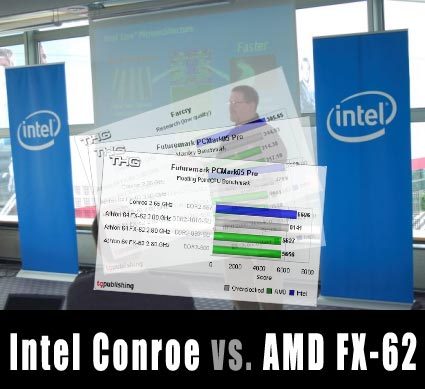First Benchmarks: Conroe vs. FX-62
Intel's Conroe Takes On The AMD Athlon 64 FX-62: First Official Benchmarks
The battle between AMD and Intel is heating up. While AMD still has the performance lead with its Athlon 64 FX-60 and FX-62 processors, and also offers better performance per watt, Intel is determined to reclaim the processor market with its upcoming Core micro architecture. The countdown has begun, and we are only a month away from the Core 2 Duo launch. This processor will replace the complete Pentium 4 and Pentium D family, targeting the Athlon 64 family in the desktop space.
From the technical specifications and what we have seen around the Internet, we are almost sure that Intel will regain the performance crown at the time Core 2 Duo and Core 2 Extreme hit the market; these processors run at up to 2.66 GHz and 2.93 GHz respectively. They feature a wide execution pipeline, architectural optimizations, and a large, shared L2 cache.
However, AMD is not asleep at the wheel; the company is in turn getting ready for its answer. This will at first be the 65 nm silicon on insulator (SOI) process and revision G Athlon 64, and later, the K8L. The K8L is rumored to introduce more HyperTransport links - with the option to support co-processors in regular AM2 or F sockets - deeper prefetching, doubled floating point units, possible DDR3 support, up to four cores per processor, and a shared L3 cache. We expect both AMD and Intel to be ready with quad core products in 1Q2007, although Intel's approach does simply merge two Conroe-type dies into one package, so it's rather simple.
Last week, Intel allowed the press to run a series of benchmarks on pre-installed Conroe test systems. Our German colleagues attended the Intel event in Germany and spent some time with the all-new systems. However, we were not allowed to release the results - until now.
Get Tom's Hardware's best news and in-depth reviews, straight to your inbox.
Current page: Intel's Conroe Takes On The AMD Athlon 64 FX-62: First Official Benchmarks
Next Page First Official Benchmarks, ContinuedTom's Hardware is the leading destination for hardcore computer enthusiasts. We cover everything from processors to 3D printers, single-board computers, SSDs and high-end gaming rigs, empowering readers to make the most of the tech they love, keep up on the latest developments and buy the right gear. Our staff has more than 100 years of combined experience covering news, solving tech problems and reviewing components and systems.

